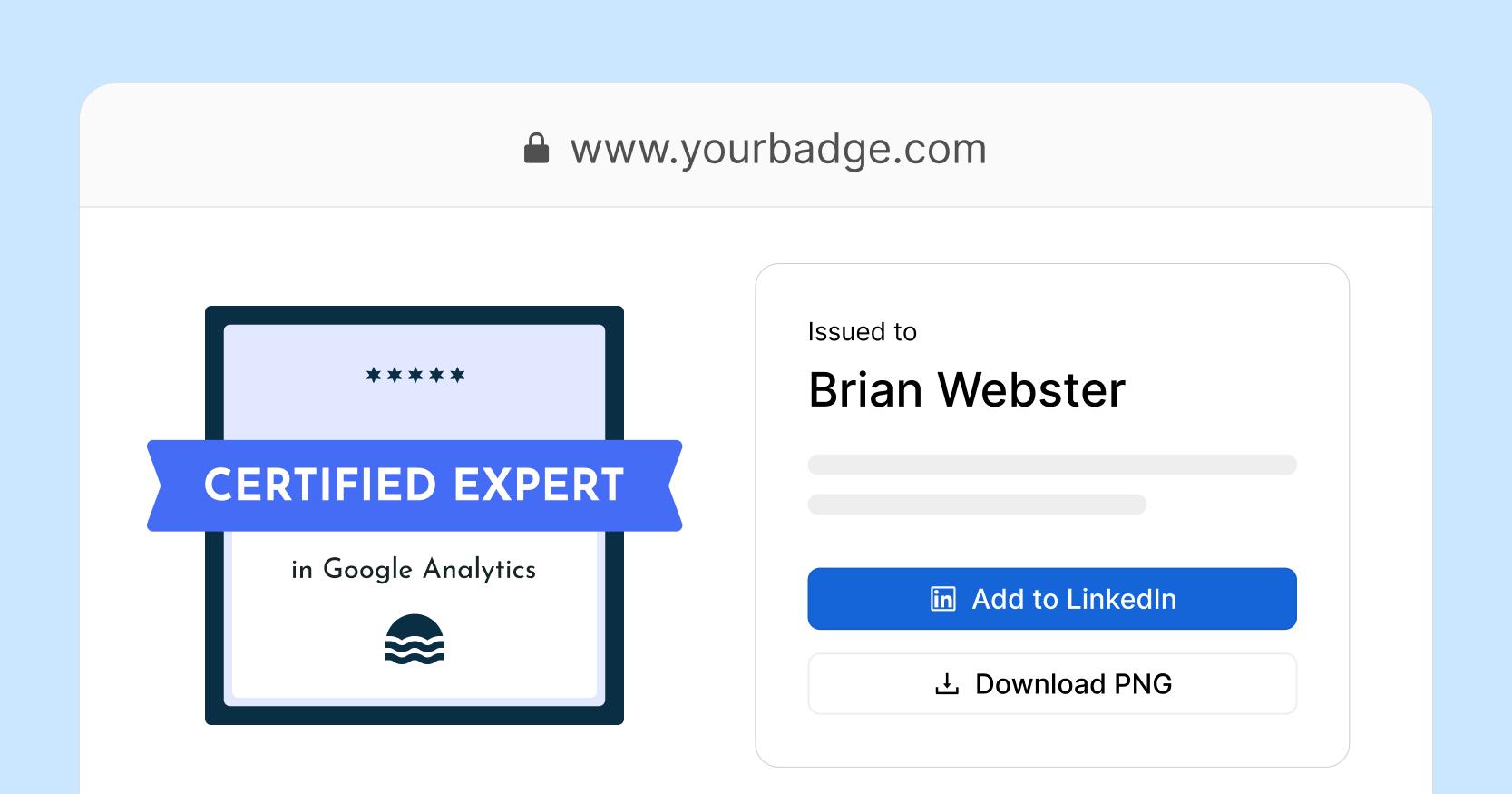Trusted by:
Updated: September 30, 2025
17 min read
Digital Badging: Tips and Steps for Implementation
Implementing digital badging can be overwhelming, with countless options and potential pitfalls. But don’t worry – we’ve got you covered. Explore the best strategies for digital badging implementation and see how Certifier makes the process seamless and stress-free.
Forget paper certificates – they're outdated. In a world where everything is going digital, how you prove your skills and achievements should be no exception!
Digital badging is a modern, verifiable way to showcase skills. Whether you're running a business or an educational institution, implementing a digital badging system can not only validate skills but also open new doors for learners, employees, and professionals.
This guide will show you how to tackle digital badging effectively so that your organization stays ahead of the curve.
What is digital badging?
Digital badging is the process of issuing digital credentials that recognize specific skills, achievements, or competencies, which can be easily shared online and verified by third parties.
Why do companies use digital badging?
Contrary to what some might believe, paper certificates are no longer the gold standard for recognizing achievement. Digital badges have risen in importance by offering verifiable proof of skills, easily shareable across platforms like LinkedIn.
Education’s new frontier. Colleges and universities are all about digital badges now, using them to track and prove students’ skills in real time. It’s the new norm in modern education.
Business buzz. Companies across the board are catching on, too. They’re using digital badges to spotlight what their team members achieve, from mastering new tools to hitting project milestones.
Employee favorites. It’s not just the management that is in love with digital badges – employees are really into them as well. They’re a clear and cool way to show off their professional growth and hard-earned skills.
Digital badging platforms are making it easier than ever to focus on verified skills and online learning, giving learners and professionals a powerful tool. And with Certifier, creating such a digital badging workflow is a breeze – easy, fast, and extremely effective, all tailored to your needs.
Digital badging vs micro credential implementation
Digital badging and micro-credentialing are often used interchangeably, but they serve different purposes. Understanding the distinction between the two can help you decide which strategy best suits your organization's needs.
Below is a comparison table highlighting the key differences between digital badges and micro credentials, providing new insights into how both approaches can be applied effectively.
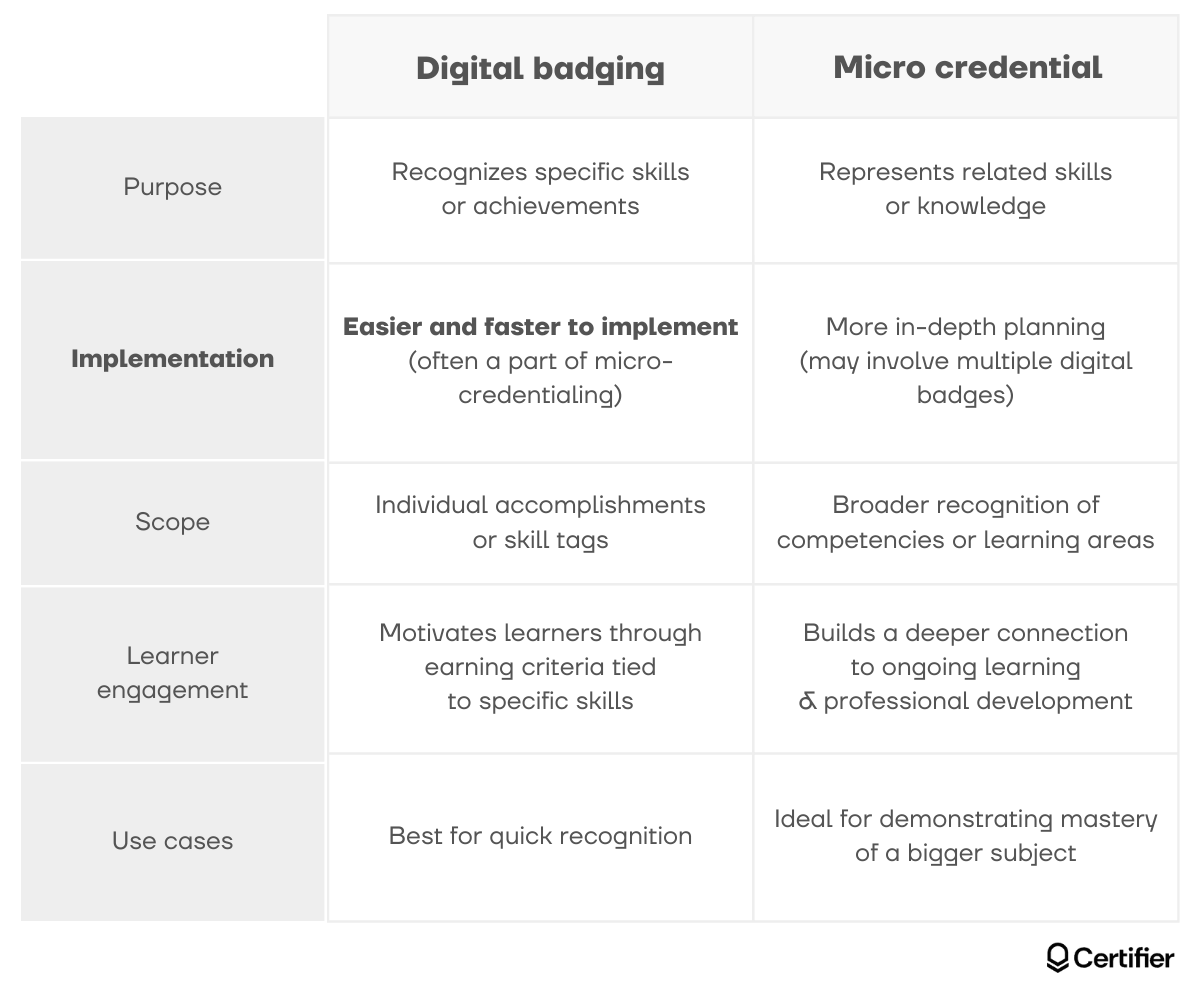
Benefits of digital badges for your business
As you can see, digital badging is more than just a trend – it’s a strategic tool that can help your business stand out on different levels. It's easy to show off team accomplishments, track skill development, or promote your brand. What else does digital badging provide?
📈 Here’s something you might not expect: digital badges can drive product interest. When IBM introduced digital badges to their courses on their training site, they saw a 64% increase in downloads of these courses. Adding badges to your training programs not only boosts engagement, but also creates leads.
Boost learner engagement and motivation
Implementing a digital badging system can transform how your organization drives learning and professional development. By linking badges to specific skills, you’ll motivate learners to actively engage and achieve more. Digital badges for students and professionals are powerful tools that can elevate your educational programs, and make them more interactive and rewarding.
Verified proof of skills for career advancement
Digital credentials offer verified proof of soft skills and technical skills. This verifiable data is easily shareable on digital resumes, email signatures, or LinkedIn profiles, enhancing career goals and showcasing competencies in a particular area to potential employers.
Cost-effective and environmentally friendly
Unlike paper certificates, digital badging platforms eliminate the need for physical materials and reduce costs for the issuing organization. These digital credentials are a step towards a greener, more sustainable future. Digital credentials aren’t just a modern solution to traditional credentialing – they’re also an eco-friendly one.
Organic marketing and networking opportunities
When your learners share their digital badges on social media, it’s not just a boost for them – it’s free, organic marketing for your institution. Each shared badge highlights your commitment to verified skills and lifelong learning. Additionally, digital badging platforms facilitate connections between professionals. They promote ongoing education and networking opportunities tied to your programs.
Does your organization need digital badging? [checklist]
If you're still relying on traditional certificates, you might be missing out on a powerful tool. Digital badges are quickly becoming a necessity for organizations that want to stay relevant.
Before you jump on board, though, let’s make sure digital badging truly fits your needs. Below is a checklist of critical questions your organization should answer to determine if implementing a digital badging strategy is the right move:
Are you looking for new ways to engage learners or employees beyond traditional training?
Do your current recognition methods lack visibility or shareability, such as badges on LinkedIn profiles?
Is your organization struggling to track or validate specific skills learned through ongoing professional development?
Would a more flexible, modular recognition system for competencies benefit your organization?
Are you trying to align your recognition system with industry standards, such as open badges and verified credentials?
Would you like to replace or complement paper certificates with easier-to-manage digital credentials?
Do you want to boost the visibility of your training programs through organic marketing on social media?
Is it important to you to provide clear, transparent criteria for earning recognition?
Do you need a scalable recognition system that grows with your organization?
Are you seeking ways to better measure the impact of your learning or professional development initiatives?
If you answered "yes" to at least three of these questions, it’s a strong sign that a digital badging program could be an excellent fit for your organization.
How does a company go about implementing digital badging? (Step-by-step guide)
Fully convinced about the benefits of digital badge system for your organization? Great job! Now, your goal and task is to implement it in your company. And this... can come with some challenges.
Implementing a digital badging program requires careful planning and alignment with your organization’s goals. Whether you're in higher education, corporate training, or another sector, this step-by-step guide will help you design a successful digital badging initiative that drives learner engagement and validates skills.
Here's how you can get started.
Step 01: Define your goals and objectives
Clearly identify what you want to achieve with your digital badging system. Are you focused on learner engagement, skill verification, or both? Defining your goals from the outset will help connect your badging program with your organization's mission and ensure that it meets your strategic objectives.
For example:
you might want to issue digital badges for students to ease their professional career growth
you can focus on using digital badges for recognition of skills and achievements in your workplace
you can issue digital badges for employees to help them move inside the company's internal structure and get promotions
Step 02: Assess your audience
Determine who will benefit from your digital credentials. Are you targeting students, employees, or external learners?
Tailor your badging program to meet their specific needs, ensuring that the badges you issue resonate with their goals and aspirations. A targeted approach will maximize the impact of your digital credential initiative.
Step 03: Choose the right digital badging system
Selecting a digital badging platform is a critical step in the process. Look for a platform that supports open badges, integrates with your existing systems, and offers detailed reporting features. This will ease the management of your digital credentials and provide you with actionable data to measure success. Scroll down to get right to the details.
🎨 Unlock full digital badging potential with our digital badge design options. Download templates in Word, Photoshop, or vector formats, or customize them online within the drag-and-drop editor.
Step 04: Develop clear earning criteria
Outline the specific skills or competencies required to earn each badge. Ensure that your badge criteria are transparent and aligned with your organization's goals. Clear earning criteria not only motivate learners but also provide verifiable proof of the skills they’ve acquired, making the badges meaningful for both – the issuer and the recipient.
Break down skills. List the exact skills or competencies that each badge represents. For example, if you’re issuing a badge for “Advanced Excel Skills,” specify that the learner must demonstrate proficiency in pivot tables, VLOOKUPs, and data visualization.
Be transparent. Make the criteria accessible and easy to understand. Share detailed guidelines on what’s needed to earn each badge so learners know exactly what’s expected of them.
Use real-world examples. Illustrate criteria with examples. For instance, if a badge is for customer service excellence, specify that it can be earned by resolving a certain number of customer issues with high satisfaction ratings.
Regularly review and update. As your organization evolves, revisit the criteria to ensure they remain relevant and challenging.
Step 05: Create a branding strategy
Design your badges to match your brand identity, so they're all consistent. However, this should not be the end of the story.
Your emails should also be branded, as well as the location where you store badges. A strong branding strategy communicates value and recognition and makes your digital badges more appealing to learners (and more recognizable to third parties!).
For example, Certifier provides an option to create a full branded experience in the digital wallet from which recipients can see, verify, share, and access the badge. It not only boosts the credibility of the badge but also strengthens your organization's brand visibility every time a badge is shared or viewed.
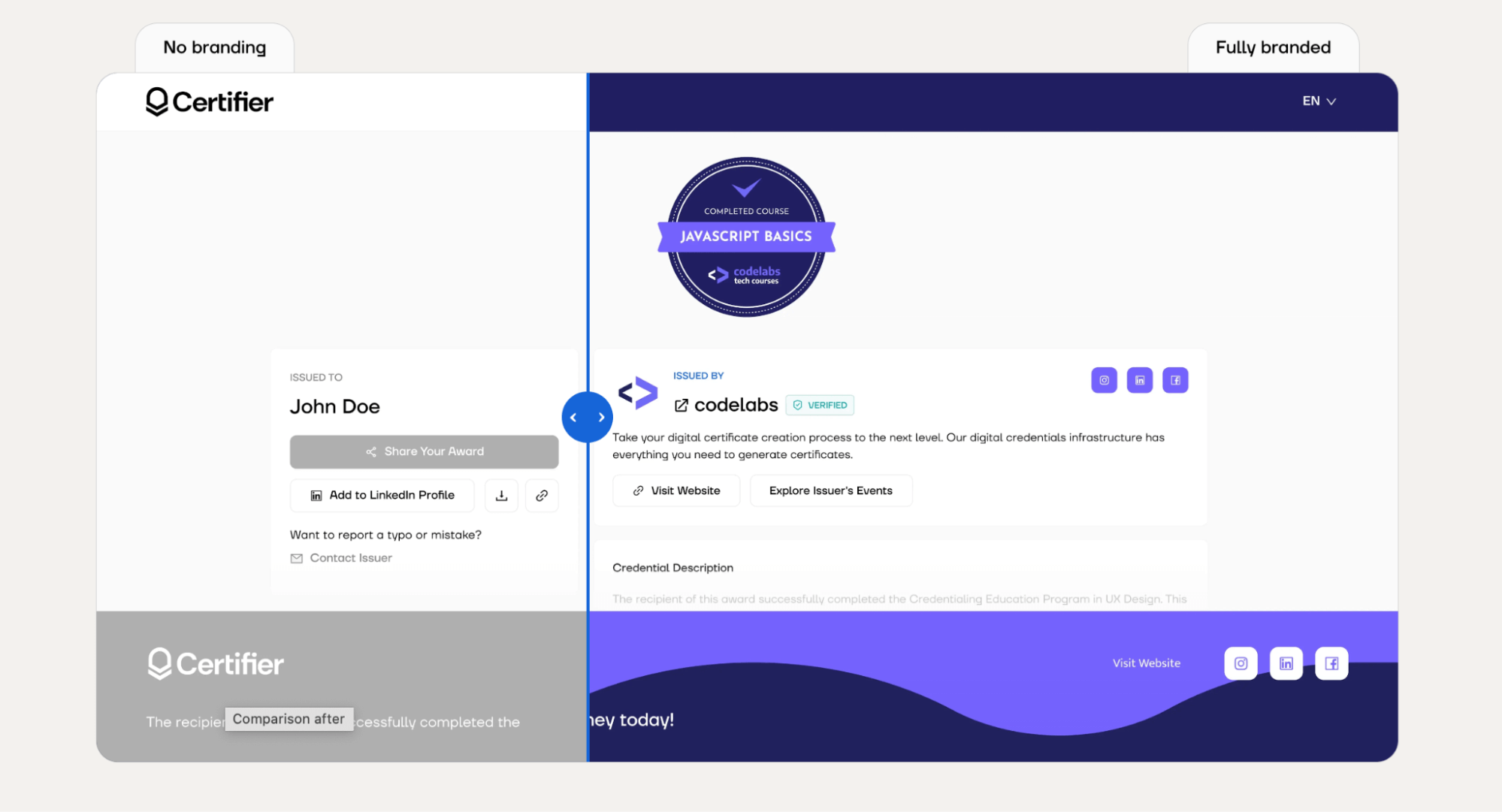
Step 06: Pilot the program and start with a test run
Before going all in, it's smart to start with a small pilot program. Pick a group of participants – students, employees, or a mix of both – to test out your digital badging system.
This test run gives you a chance to gather valuable feedback and spot any potential hiccups early on. By refining the process during this phase, you can make sure that when you roll out the digital badges to everyone, everything runs smoothly and effectively.
Step 07: Integrate with existing programs
To make digital badging truly impactful, it should seamlessly integrate into what your organization is already doing. Whether it's for ongoing professional development, continuing education units, or specific online courses, tie your digital badges directly to these initiatives.
For example, digital badges in higher education can be linked to course completions, while a badge system for employees might be connected to skill development programs. By embedding digital badges into existing structures, you make them relevant, accessible, and a natural part of the learning experience.
Step 08: Communicate the value of digital credentials
Communication is key when it comes to getting your audience excited about digital badging. Make sure they understand why these badges matter.
Emphasize how digital badges provide verified proof of skills and achievements that can easily be showcased on digital resumes, LinkedIn profiles, or email signatures. This not only boosts the badge holder's visibility but also enhances their credibility in the eyes of employers or peers.
When people see the tangible benefits of digital badging in education or in the workplace, they’re more likely to engage with the badging system and strive to earn more badges.
Step 09: Plan for scalability and long-term support
To keep your digital badging system effective over time, think about the future from the very beginning.
Set up a dedicated team or allocate resources specifically for the ongoing management of the badging system. This team will be responsible for tasks like updating badge criteria, managing badge expiration dates, and ensuring that the digital badging system remains aligned with your organization’s evolving goals.
Step 10: Measure success with digital credential data
The success of your digital badging program doesn’t end with badge issuance. To keep it effective, you need to continuously monitor its performance.
Use the data from your digital badging system to track important marketing metrics like how many badges are shared or engagement levels. This data gives you insight into what's working and what might need tweaking.
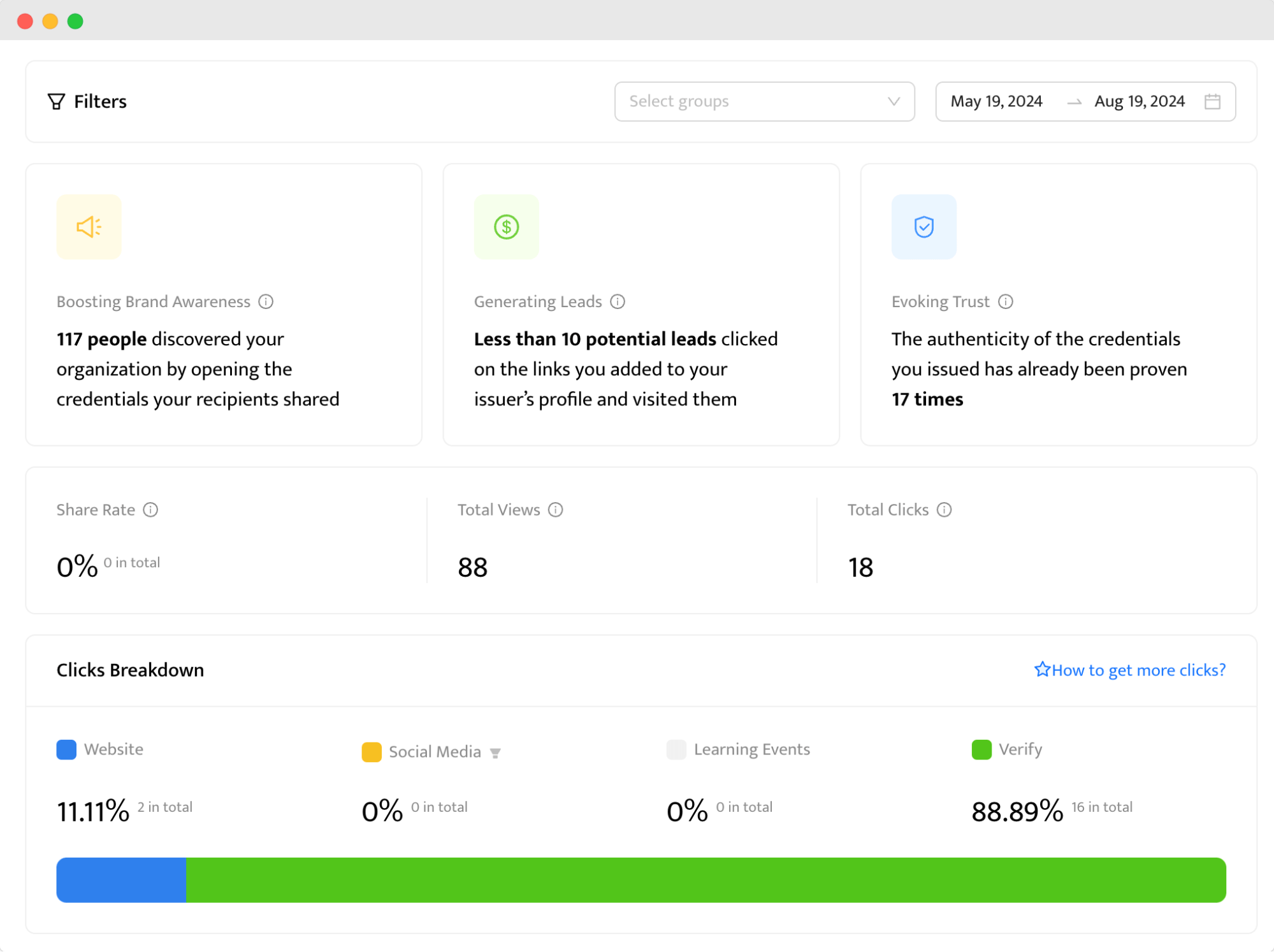
Some digital badginging systems like Certifier provide additional useful data like how many people discover your organization or how many of them generate leads. By staying data-driven, you ensure that your badges continue to motivate, engage, and provide value to all stakeholders involved.
How implementation of digital badging looks for certain groups?
Curious about how digital badging plays out across different groups? Let’s check out how digital badging can be tailored and implemented for various audiences. In education, workplace training, or personal growth initiatives, each group experiences digital badges in unique ways.
Here are some key ways to leverage digital badges effectively across different areas.
Digital badges for students
Digital badges in education offer micro credentials that recognize specific skills gained throughout a student's learning journey. Universities can issue digital badges for students for achievements such as project management or research participation, making them a supplement to traditional degrees.
For example, a university might issue digital badges to students who complete specialized courses, giving them a way to share these credentials on their LinkedIn profile.
Unlike a paper certificate, digital badges can provide detailed information about the specific competencies mastered.
👋 Tip from experts: Digital badging education usually means a lot of skills gained through all courses. An important feature is the ability to highlight the ones that are most important for the particular credential. This lets stakeholders see what a credential entails for a student with a quick glance.
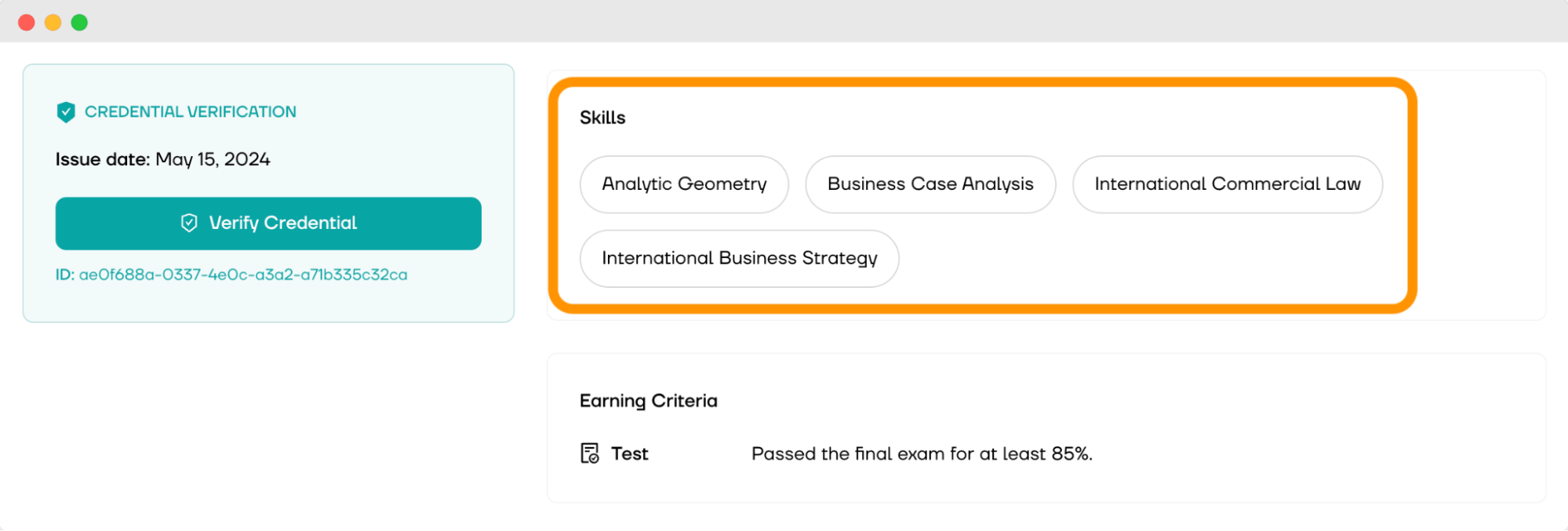
Digital badges for employees
In the workplace, digital badges can be used for competency-based recognition, helping employers track and validate employee development. Credentialing organizations can issue digital badges to employees who complete internal training programs or certifications.
For instance, a company might issue digital badges for completing a leadership training course. Then, employees can display their digital credentials in their email signatures.
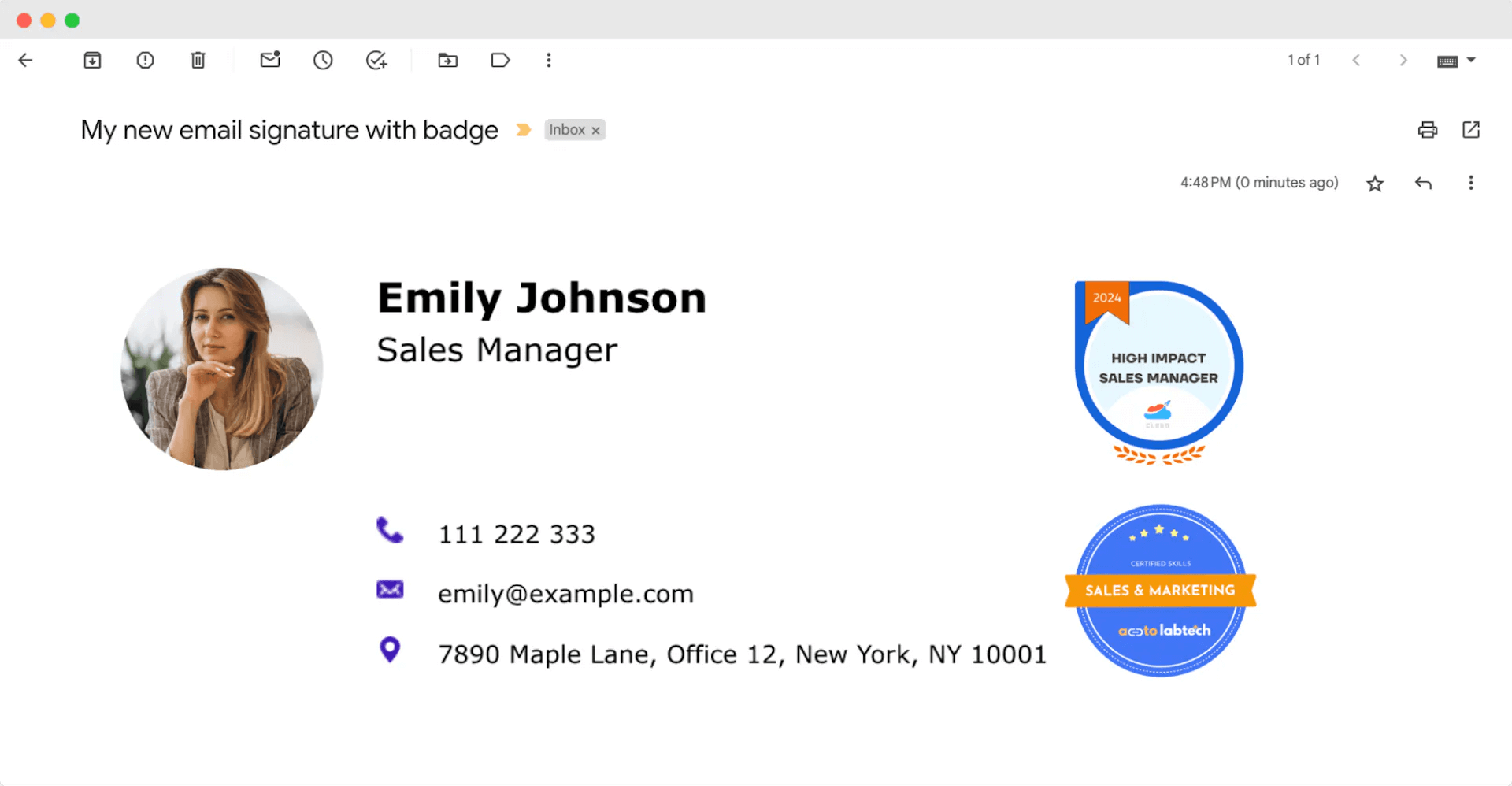
🚀 Did you know that implementing digital badging can significantly boost your company’s training outcomes? For example, IBM saw a 129% increase in course enrollments and an incredible 694% jump in course completions after introducing digital badges. Clearly, digital badges can be used to engage employees and drive measurable results.
Digital badges for recognition of skills and achievements
Digital badges are also valuable for personal development, allowing individuals to showcase new skills. Many organizations, such as professional associations, issue digital badges to members who participate in specific programs or workshops.
For example, a person might earn digital certificates for completing a personal finance course, which can then be added to their Licenses & Certifications section on LinkedIn.
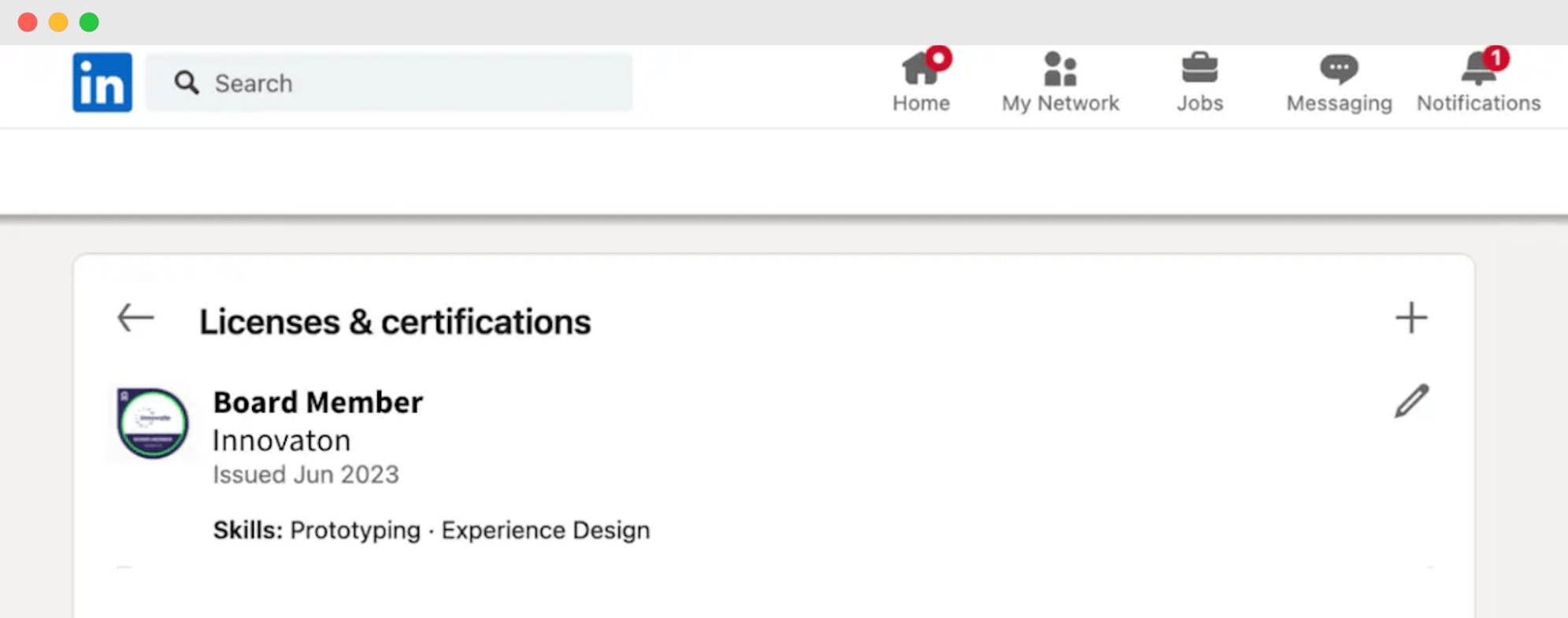
Digital badges for professional associations
Professional associations can leverage digital badges to recognize the achievements of their members who meet certain standards or complete certifications.
For example, a professional association might issue a digital badge to members who complete advanced training programs, providing a verified digital credential that never expires.
Naturally, this not only helps to recognize achievement but also enhances the association’s reputation as a leader in competency-based recognition.
👩🏼💻 Get to known more benefits of badging program for association members.
Digital badges for continuing professional development
Implementing digital badges for continuing professional development is a smart way to track ongoing progress and keep the learning process dynamic and engaging. It's not just about ticking off completed courses – it's about building a portfolio of skills that are easily shareable and respected in a field.
👋 Tip from experts: You can set expiration dates on badges to ensure that skills stay current. This keeps the badge system relevant and encourages learners to renew their credential on time. Whenever the day zero comes, Certifier sends an automatic follow-up email to the recipient. You can track the expiration date within the management dashboard.
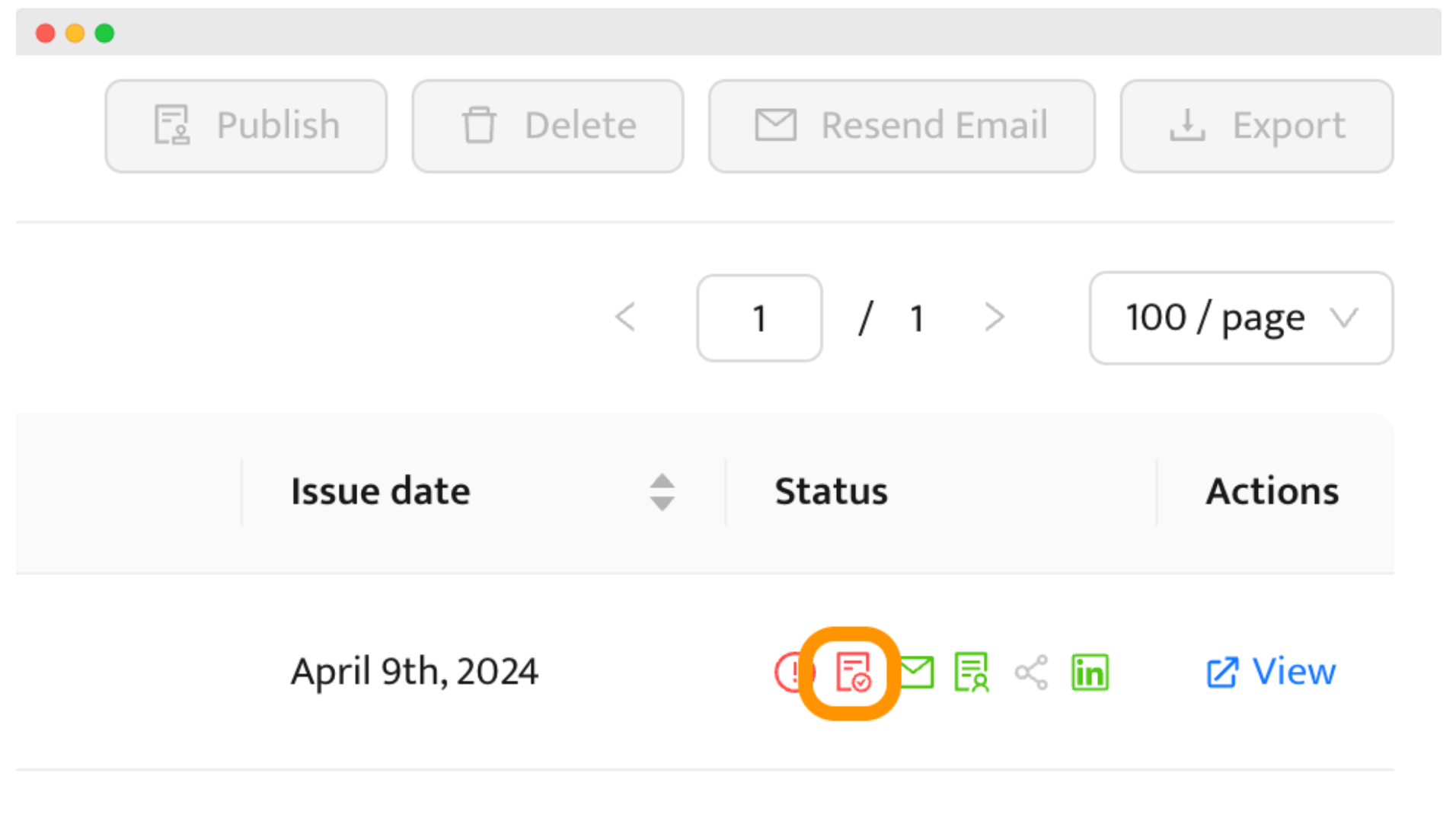
If you want to learn more about digital badging and its use cases, check our guide on digital badges.
Digital badge implementation mistakes to avoid
When implementing digital badges, many businesses make avoidable mistakes that hinder their success. Here are four common mistakes and how to avoid them:
Issuing badges manually instead of automating the process. It takes time and is error-prone to issue digital badges manually. Automation through a dedicated badging platform saves time, ensures consistency, and allows for easy scaling. Make sure to integrate a digital badging system that automates the issuance process and connects with your learning management or credentialing systems from the start.
Failing to define clear earning criteria. One of the biggest mistakes is not setting transparent, specific criteria for earning badges. Vague criteria can confuse learners and devalue the badge. Ensure that every badge has well-defined, competency-based recognition standards, clearly communicated to all participants. This clarity helps motivate learners and establishes credibility for the badges.
Not aligning digital badges with organizational goals. Another common mistake is implementing a digital badging program without aligning it with your broader business objectives. If the badges don’t support your strategic goals, they can become disconnected from your organization’s mission. Before launching, make sure that the digital badges reinforce key objectives – no matter if it’s increasing employee engagement, improving skills, or boosting learner mastery.
Underestimating the importance of communication and marketing. A digital badging program is only effective if your audience understands its value. Failing to communicate the benefits of digital credentials can result in low participation rates. To avoid this, create a marketing and communication plan that highlights the value of digital badges to learners, employees, and external stakeholders. This can include showcasing success stories, using social media, and providing training on how to use and share digital badges effectively.
Avoiding these common pitfalls will ensure your digital badge implementation is efficient, aligned with your goals, and truly impactful for your organization.
Which digital badge platform is right for my organization?
You need to use a platform that can handle all aspects of digital badge implementation and management.
The platform you select will shape the experience of those receiving them – such as students, employees, or other stakeholders.
To chose the best badge maker, here are key factors to consider.
Ease of use
Intuitivity is essential when choosing a digital badging platform – you want something that works well, but is also fairly easy to use. Certifier, for example, offers a user-friendly interface that simplifies the process of creating, issuing, and managing digital badges.
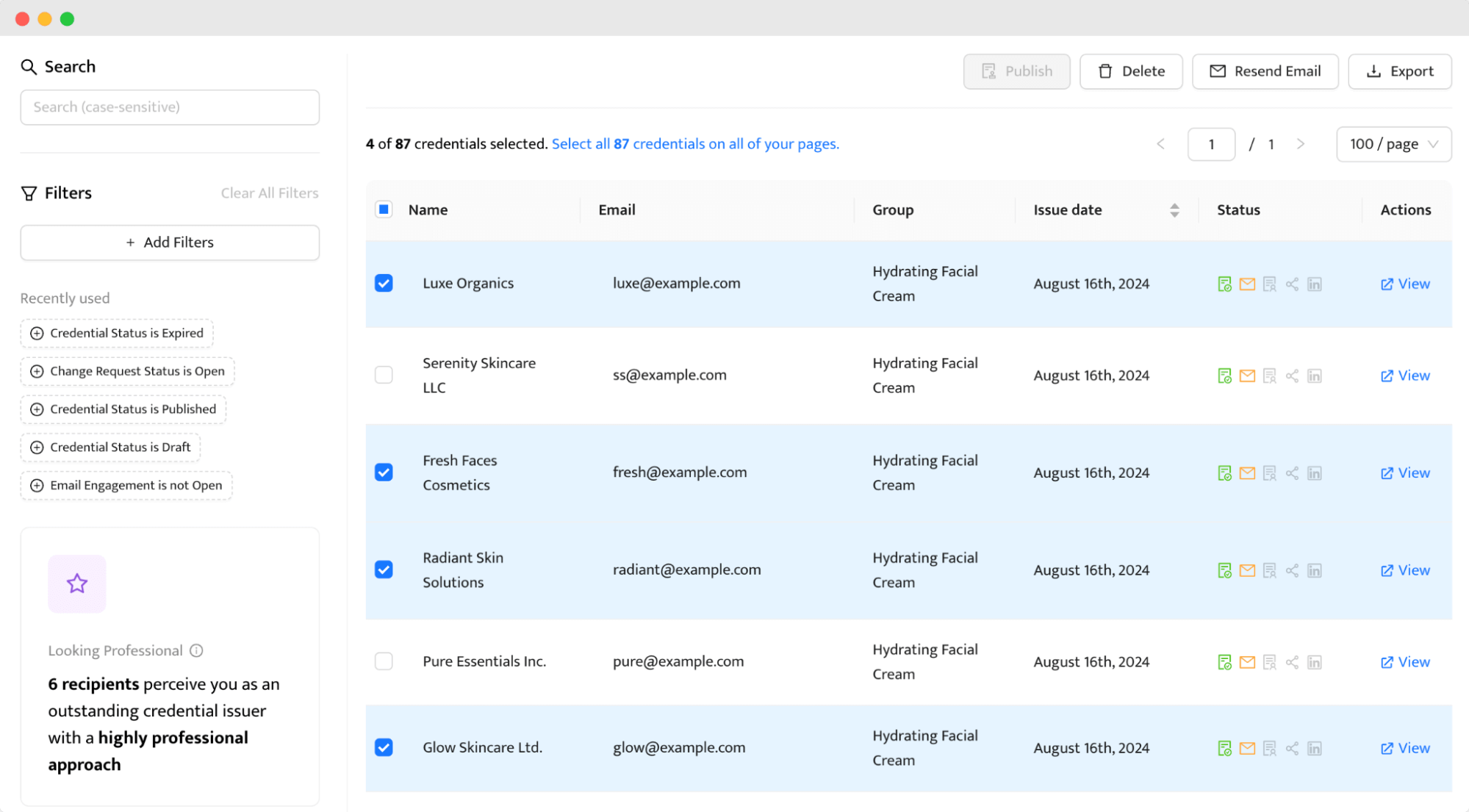
Make sure the platform you select allows both administrators and badge earners to use the system with minimal friction for a smooth experience for everyone involved.
Integration with existing systems
If your organization already uses a learning management system (LMS) or credentialing management system, make sure the digital badging platform you choose integrates smoothly with your current systems.
👋 Tip from experts: If you're issuing digital badges in bulk, you can generate them automatically based on the data from your CRM or LMS system. Integrate the tools so that once you put the recipient data, the digital badging system will automatically generate a new credential with all the accurate information. Learn more about Certifier integrations.
Cost structure
Understanding the cost of a digital badging platform is essential. Costs can vary based on:
the number of badges you plan to issue
the size of your organization
the features you need
Some platforms offer transparent pricing on their websites, while others require a custom quote.
Remember to factor in both the upfront costs and any ongoing fees for maintenance or support. Compare low-cost and premium options to see which fits your budget best without sacrificing necessary features.
And if you want to use a free digital badging system, Certifier provides a free plan for up to 250 badges issued yearly. Such options as expiration dates, bulk generation, analytics, customization, are all included.
Create and Send Digital Credentials
Key features
Not all digital badging platforms offer the same range of features. You’ll want to evaluate what’s most important for your organization. Consider if the platform offers customization options, such as branded badges, and the ability to share badges easily on social media.
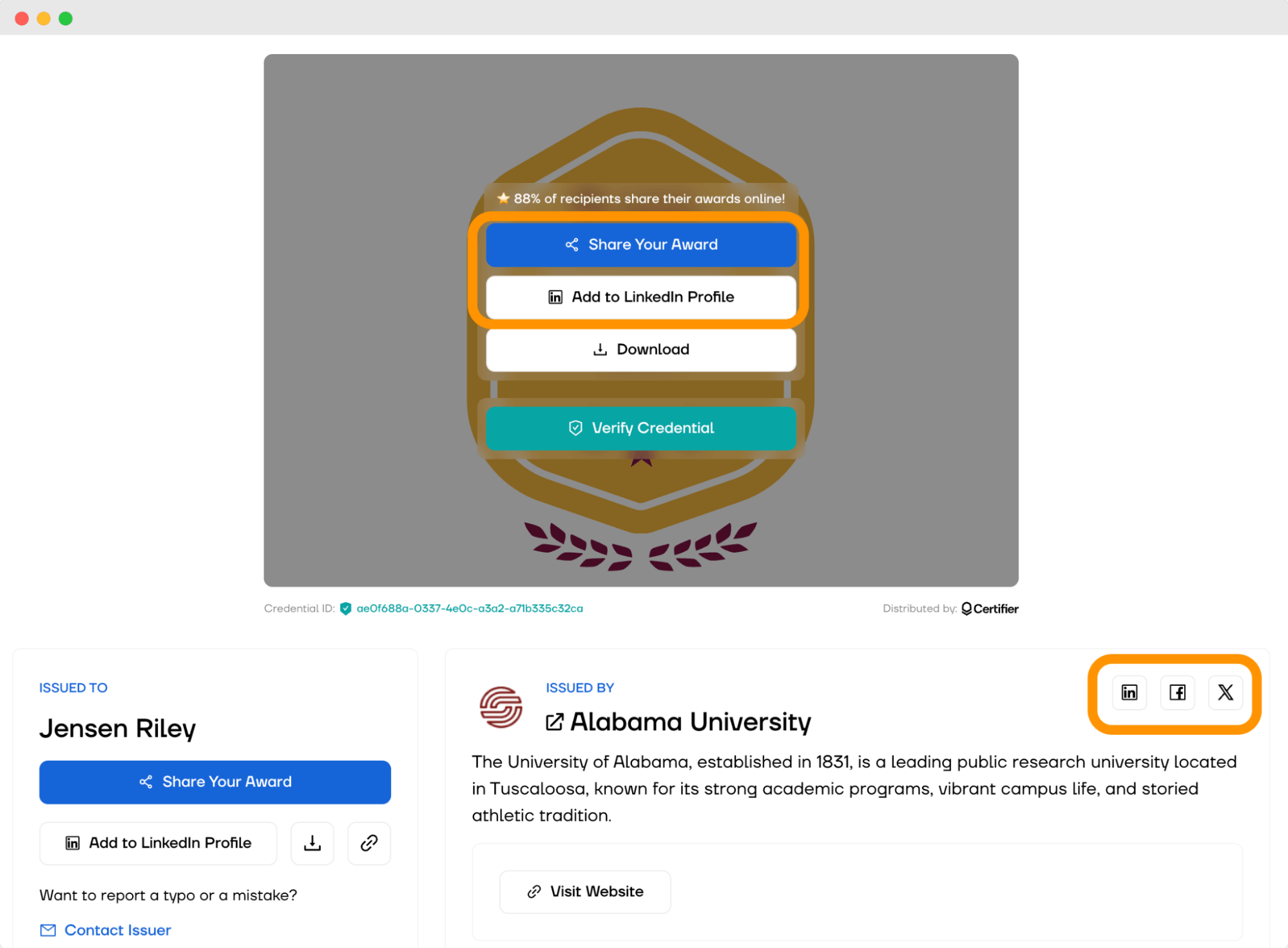
Another feature to look out for is job market insights, which can help learners understand how their badges can be used for career advancement. On top of that, check if the platform supports communication with badge earners, like branded email reminders to redeem their badges, which can be useful for increasing engagement.
Reporting and analytics
A good digital badging platform should offer robust reporting tools. These tools help you measure the success of your program by providing data on how many badges have been issued, redeemed, and shared.
Look for platforms that offer dashboards or detailed reports that allow you to track the effectiveness of your badging efforts. This data will be crucial in fine-tuning your digital badge implementation and management over time.
Customer support and onboarding
The level of support provided by the platform is another critical factor. Some platforms offer extensive onboarding resources, including training guides, webinars, and dedicated support teams to help you get started. Others may provide fewer resources, leaving more of the setup and management in your hands.
Understand what ongoing support your organization will need and choose a platform that aligns with those requirements. This is especially important if you're new to using digital badges to recognize skills and achievements.
Top digital badge implementation and management
Implementing a digital badging system can transform the way your organization recognizes and validates skills. By carefully selecting the right platform, avoiding common implementation mistakes, and aligning your badges with clear goals, you'll set up a successful digital badging program.
Remember to automate where possible, communicate the value of badges, and continuously measure success. Now it's your turn!
If you're ready to build a frictionless digital badging system, Certifier is here to help. With easy-to-use tools and a user-friendly interface, Certifier makes it simple to create and manage your digital badges. Enjoy for free!
FAQ about digital badging implementation
Need some answers? Here, you can find the most frequently asked questions about digital badge implementation and management.


